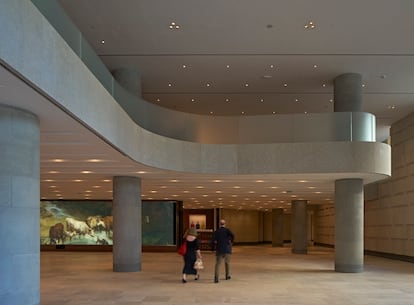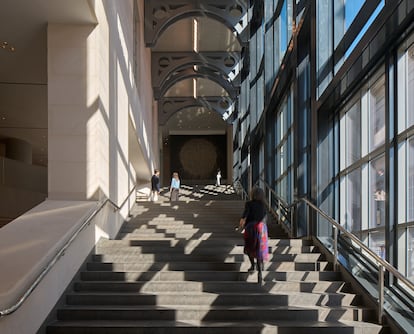London's National Gallery redesigns its headquarters and joins the era of civic museums.

From attraction to frame. The intervention by Annabelle Selldorf (Cologne, 64) and her team to facilitate the growing flow of visitors—more than five and a half million—received annually by London's National Gallery showcases "the nothing effect, " the same one the German architect already employed in the expansion of the Frick Collection inaugurated in New York last April. The formula is barely visible and is as much about strategy as design. In London, on May 10, the National Gallery will inaugurate its bicentennial year by changing the main entrance to the art gallery. This is no small gesture; it's a declaration of intent. The objective? To ensure that architecture avoids the formation of visitor queues, thus increasing visitor numbers and the quality and comfort of the visit. It's about updating the idea of the museum from a place of the muses to a public space. The goal is to welcome a different kind of audience.
The director of the National Gallery, Gabriele Finaldi , requested a project that would make people who had never set foot in the museum feel welcome. Selldorf, who opened his studio in Manhattan at the age of 28, did so by clearing the space and bringing natural light into the Sainsbury Wing, the extension designed by Robert Venturi and Denise Scott Brown just over 30 years ago, which, at the time, was not designed as a main entrance. Over these three decades, technologies, urban planning, and other social considerations have evolved. Thus, today, attention is paid to ensuring that those arriving in a wheelchair can easily access the same main entrance as everyone else, without detours to ramps or traveling to back entrances. Civic improvements have gone from being a patch to becoming a goal.
“It was more a matter of physics than design,” explains Selldorf. “Today, technology exists to provide warmer, more energy-efficient lighting.” A new, serene sandstone pavement expands the light, and the old dark glass panes, which hid the iconic staircase crowned by metal trusses designed by Venturi and Scott Brown, have been replaced with transparent glass that filters heat, lets in more light, and allows for contact with the city. “The goal was to welcome, connect, create space for everyone, and facilitate circulation,” says Selldorf.

Spatial cleanliness, order, and connection are the sensations experienced within a project that cost almost 100 million euros. The experience is one of lightness and transparency. That's why changes aren't announced. They have to be sought out. Thus, security checkpoints have been reduced to two barely visible poles that not only take up little space but also avoid waiting times and queues. The revolving doors have disappeared, but the warmth remains intact because there is a double door. There are no steps. Everything flows.
Among the most drastic decisions of this remodeling are a disappearance and an appearance. The museum's largest shop, located at this entrance in the latest expansion, has disappeared, crumbled into small stalls. The appearance is a 10.6-meter-long screen, the sole decoration of the lobby. It is the highest-resolution screen in Europe. It is also a drawcard. And a study tool. On it, details of Velázquez 's Venus with a Mirror coexist with foreshortened versions of Hans Holbein's The Ambassadors . Twenty of the Gallery's masterpieces are gradually revealed in detail, almost as if we were navigating through the canvases. We can make out the shoes in Van Eyck 's Arnolfini Marriage , we can intuit the furs of Titian 's Bacchus and Ariadne , or we can accompany Vermeer 's Young Woman Playing the Virginal . All the art gallery's periods are revealed on the screen: from Odilon Redon 'sOphelia among the Flowers to Caravaggio's Supper at Emmaus . Visitors' eyes are lost in the depths of the landscape in Da Vinci's Madonna of the Rock or Constable 's The Haywain . All this before entering.
“I could spend all day sitting in front of this screen,” Selldorf notes, praising Finaldi ’s idea. “We all lose when someone thinks the National Gallery isn’t for them,” the director insists. Two centuries ago, when William Wilkins designed the neoclassical building facing Trafalgar Square, it was common for power to speak from a pedestal. Over time, museums traded their neoclassical facades for more expressive resources and spectacular inventions, with content and container competing for the public’s attention. Today, the National Gallery champions the museum as a place of conviviality. For a notion of culture that puts enjoyment before business, offering proximity and discovery.

Gabriele Finaldi announced that, in the year of its bicentenary, the National Gallery would be putting everything on display. For 12 months, there would be no loans or repairs, he added after three years of enduring the transformation of its Sainsbury's wing. Perhaps Selldof's greatest challenge was the one he shared with heritage experts from the firm Purcell. What could be touched and what couldn't in a postmodern building? The controversial extension by Venturi & Scott Brown spoke in detail, while adding volumetrically to the original neoclassical building. But… as the couple's only project in Europe, this extension enjoys the highest protection as a property of artistic interest. That's why the changes have been more technological than visual. More functional than easy to see. They are, however, easy to feel. What remains of that building? Everything and nothing at the same time. The building is the same, but not only has it been given a facelift and freed from the cornices added as a postmodern makeover, it has also been revamped: the columns have been reduced in size, part of the floor has been removed, and the mezzanine walls have been converted into railings. The famous staircase, with its metal trusses as a nod to the Industrial Revolution, has been rejuvenated.
The landscaping by the Vogt studio, which designed the gardens of the Tate Modern and the Eiffel Tower , has also been a subtraction. Decorative flowerbeds from the former caretaker's house have disappeared in favor of the pedestrian connection to the gallery. Finaldi summed it up: "This new entrance treats visitors with the quality of the works we exhibit: unsurpassed." That is the work of Selldorf , Purcell, and Vogt : "It is the only reasonable entrance for a museum with the demands of this century, that is, with consideration for the needs of every visitor," Finaldi notes. But it is also a strategy that has relocated services and prepared for future underground connections. The greatest achievement of the project is that all this complexity has been made invisible. It seems as if everything was always there. Nothing could be further from the truth.
EL PAÍS



%3Aformat(jpg)%3Aquality(99)%3Awatermark(f.elconfidencial.com%2Ffile%2Fbae%2Feea%2Ffde%2Fbaeeeafde1b3229287b0c008f7602058.png%2C0%2C275%2C1)%2Ff.elconfidencial.com%2Foriginal%2Ffcb%2F42b%2F2f1%2Ffcb42b2f16501c7805d3e3fa7a9a97e7.jpg&w=3840&q=100)
%3Aformat(jpg)%3Aquality(99)%3Awatermark(f.elconfidencial.com%2Ffile%2Fbae%2Feea%2Ffde%2Fbaeeeafde1b3229287b0c008f7602058.png%2C0%2C275%2C1)%2Ff.elconfidencial.com%2Foriginal%2F609%2F1b7%2Fb15%2F6091b7b156b9f1b799b6bc040a5f6265.jpg&w=3840&q=100)
